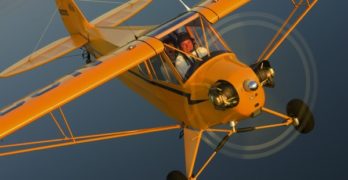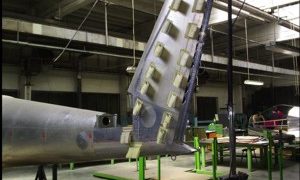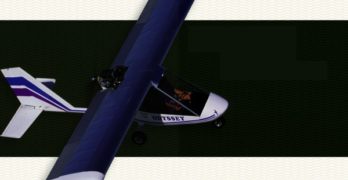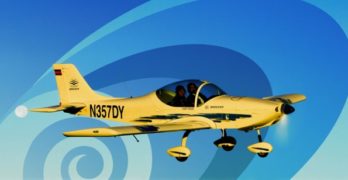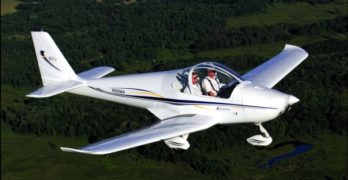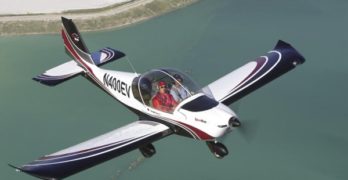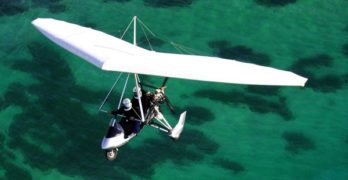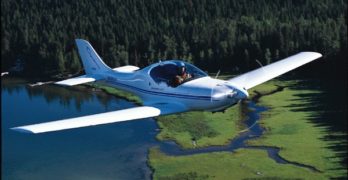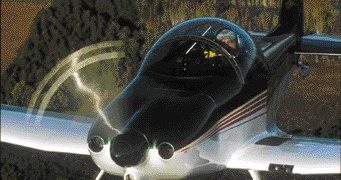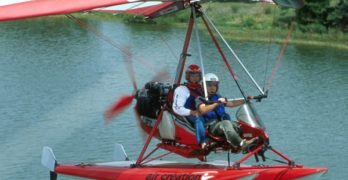Familiar…Yellow…Tandem…FUN!
Many light-sport aircraft
(LSA) aspire to a
futuristic look, using
exotic materials like
carbon fiber with
shapes that are sleek and finely contoured.
Other designers chose another
niche. American Legend Aircraft
Company of Sulphur Springs, Texas, is
one of three companies that have recreated
the venerable Piper Cub, which
has so captured the imagination of the
general public that the words “Piper
Cub” are used by the unknowing to
describe almost any airplane without a
jet engine.
Pilots know better. Yet among the
immense range of aircraft available,
the Piper Cub maintains a favorable,
nostalgic image. Doesn’t every pilot
have a warm, fuzzy feeling for the little
yellow tandem-seater? Three companies
now target this interest under
the new LSA category. (We’re featuring the Legend Cub
but will describe
the other two-the
North American Sport
Aviation Savage and Cub
Crafters’ Sport Cub-in
sidebars.)
American Legend’s Cub
was the first of the three to earn special
light-sport aircraft (S-LSA) certification
under the ASTM consensus standards.
Search Results for : CT AND hand control
Not finding exactly what you expected? Try our advanced search option.
Select a manufacturer to go straight to all our content about that manufacturer.
Select an aircraft model to go straight to all our content about that model.
A Glimpse at the S-LSA Certification Process
Tom Gunnarson
Recreational aircraft ownership can bring
great joy and satisfaction. From the pride of
knowing a plane is solely yours to outfitting it
to your personal tastes to the convenience of
flying it where and when you desire, private
ownership can bring many joys.
The new sport pilot and light-sport aircraft
(SP/LSA) regulations are reawakening interest
in basic flying in non-complex, two-seat aircraft
harkening to the golden age of aviation
when requirements for personal flight were
minimal. New-age materials, components,
and manufacturing processes, along with an
existing worldwide industry producing aircraft
to strict weight limits, have created a plethora
of ready-to-fly aerial deuce coupes just waiting
for the right regulatory environment to
burst on the American recreational aviation
scene. Not surprisingly then, the first aircraft
certificated in the special light-sport aircraft
(S-LSA) category were imports from Europe
where manufacturers have been building
these aircraft for 20 years.
The S-LSA certification process includes
many elements found in standard, productioncertificated
aircraft manufacturing.
Earthstar’s Odyssey Continues
After flying many ultralight and light-sport aircraft, I’ve found the handling
and performance characteristics of Earthstar Aircraft’s machines
suit me as well as or better than any others. With that said, let me
tell you about some significant changes that may thrust this small
California company into the mainstream of light-sport aviation.
Mark Beierle created the Thunder Gull series of ultralights after working in the
aerospace industry … and being discouraged with the ultralights available in the
early 1980s. He was interested in perfecting his designs, so his priority was not producing
numerous units. Instead, he wanted to produce an aircraft with classic flying
characteristics. Customer response to his machines was excellent, but delivery
often stretched into months, even years. To own a prized Earthstar model, you had
to have patience. This situation gave another company, Titan Aircraft, a chance to
build a similar design, the Titan Tornado, and its business took off while Earthstar
remained deliberately small.
Breezing Along
Like American
ultralights, European
microlights have paved the way
to a new breed of aircraft for European
fliers. Residents of the European community
don’t have the sport pilot/light-sport aircraft
(SP/LSA) rule, but they know how to build the planes
that serve the market.
Comco-Ikarus is one of Germany’s most
established microlight builders. After a
long and successful run with its C22
and C42 airplanes, the company,
based in Hohentengen in
southwest Germany, is
ready to run in LSA
circles with its
new Breezer.
Compared to the C22 and C42,
which is still being sold in Germany and
the United States, the Breezer is clearly
an original design. The Breezer has a
metal wing and tail, whereas the C42
has a fiberglass fuselage and its wings
are constructed of aluminum tubes and
covered with an advanced sewn textile
called GT-Foil, a Kevlar-based material.
The Breezer is a low-wing airplane,
whereas the C42 is a high-wing; the
C42 is strut-braced, while the Breezer
is cantilevered.
Kappa KP-5 An All metal Beauty
Kappa’s KP-5 … a great trainer and more!
At EAA AirVenture Oshkosh
2005, 13 aircraft on
display in the Light-Sport
Aircraft (LSA) Mall-
which put LSA on center
stage just south of AeroShell Square-
had their airworthiness certificates as
special light-sport aircraft (S-LSA). (A
14th aircraft, the Savage Cub, exhibited
in the North Commercial Area,
also earned its S-LSA certificate, but
only had one aircraft to display.) That
14 aircraft earned S-LSA certificates
in the short span of three and a half
months since the FAA announced
the availability of the final consensus
standards for LSA-category airplanes
is an unprecedented accomplishment.
No one can recall when so many airplanes
have been certificated in such
a short time.
One of those baker’s dozen plus
one is the Jihlavan (pronounced
“YEE-la-von”) KP-5, better known to
Americans by its importer’s name-
Kappa Aircraft KP-5. It is an elegantly
styled, all-metal LSA with a high-visibility
cockpit, a high-performance
wing with well-regarded Fowler
flaps, tough trailing link landing
gear, and the popular Rotax 912
powerplant.
A Sporty SportsStar: Leading the LSA Parade
Being first is often good in marketing, sports, or life in general, for that matter. In the light-sport aircraft (LSA) certification race, one aircraft has already won: the Czech Republic-built Evektor SportStar. This all-metal, low-wing, bubble-canopy design was the first aircraft to win its airworthiness certificate as a special LSA (S-LSA), and no one can ever take that distinction away.
Evektor Aerotechnik appointed Sport Aircraft International of Kerrville, Texas, as its American distributor. That company is currently in the process of transitioning to Evektor America as its new trade name. At EAA AirVenture Oshkosh 2005, it exhibited a beautifully finished SportStar SE alongside Evektor’s four-seat Cobra, which is aimed at the Cirrus market. In the LSA Mall, another SportStar presented itself to thousands of visitors.
I flew the first imported version of the SportStar, then called the EuroStar, a few years ago. The day after EAA AirVenture 2005 ended, I was delighted to join Evektor America President Jeff Conrad and rocket down Wittman Field’s runway in the newest SportStar SE (special edition).
AirBorne’s XT 912 Trike
Racing to be the first weight-shift S-LSA
In early January, the FAA accepted the ASTM consensus standards
for weight-shift control (WSC) aircraft, commonly known as trikes.
The agency’s action paved the way for trike manufacturers to certificate
ready-to-fly machines as special light-sport aircraft (S-LSA). Now,
the race is on to see which company will be the first to complete the
steps necessary to show compliance with the newly approved standards.
One company in the running is
AirBorne Australia, and it is already
accepting orders for its S-LSA model,
the AirBorne XT 912. How can it be so
confident this model will comply? Its
machines already meet Australia’s tough
certification standards, so the effort is
primarily one of paperwork. (Though
preparing documents to the FAA’s precise
requirements is no trivial task, as
anyone who has tried to correctly fill
out the sport pilot certificate application
knows.) Interestingly, Australia is
one of two nations-Colombia is the
other-that have accepted the sport
pilot/light-sport aircraft (SP/LSA) rule
as part of their national program.
Dawn of the Dynamic
While many American pilots focus on SportPlanes™/ light-sport aircraft (LSA), sales of amateur-built kits continue. As the government crawls toward release of the new rule, the WT-9 Dynamic from Aerospool is one that might go both ways.
You might choose a fixed-gear, Rotax 912 80-hp model that U.S. importer Dan Defelici believes may meet the proposed regulation. But today you can buy a retractable Dynamic and build and fly the speedster around the U.S. under the 51% rule. Since LSA will probably not allow retractable landing gear, flying a retractable WT-9 will require more than a Sport Pilot license.
Getting Some Help
The 51% rule intends that the owner of a kit airplane should build more than half of the plane. The FAA has created extensive checklists to assure that a wide variety of kits meet this rule. Factories often do the hard parts that require jigs and other special equipment.
World’s Fastest Mustang II?
When most of us think about a fast airplane, we sketch in our minds a sleek and smooth exterior and wings that allow the graceful machine to slip through the air with the least possible resistance. We think the engine is also important and that more power is better than less.
But according to race winner Brian Schmidtbauer, up to 30% of the total drag in an aircraft can be cooling drag, or air movement through the engine compartment.
Because I often review gliders and slower powered aircraft, I’m sure I displayed a slack-jawed response to this comment. The stunned expression stayed on my face as Schmidtbauer described detail after detail about the handling of cooling air.
After an hour-long flight in his blazing Mustang II, I came away a believer. His homebuilt aircraft has beaten the likes of jet-smooth Lancairs and isn’t threatened by speedy RVs. In fact, only his buddy and RV-4 pilot Dave Anders has beaten Schmidtbauer in a race, and they’re so close that the next race might be different.
Air Création’s High-Performance Floats
Air Création is a serious company and a world-class trike builder with an impressive sales record. Their serious trikes sport beautiful hardware and numerous customized components. Right down to their trademark red color, Air Création is serious about building a remarkable trike, a series of them in fact.
So when Air Création puts a float set on the market, you can count on the fact that it was well researched and exquisitely crafted.
Now, let’s combine that with the XP-17 wing, the largest in the company’s XP series. Floats are mounted under and the wing atop a GTE trike carriage which has been in production for several years. Put this all on a lake in Florida and you have the makings of an interesting experience.
Another 20-Year Veteran
Gilles Bru and Jean Yves le Bihan founded the French company in 1982. Air Création’s dealer in Canada reports, “It has grown steadily ever since, building around 4,000 wings and 2,500 trike-units for sale in more than 50 countries.”
Today Air Créationemploys 25 people, four of whom are in the technical department designing new products, and 14 work on the production of ultralight trikes and wings.With annual sales of about $2.5 million, Air Création exports 60% of its products.
- « Previous Page
- 1
- …
- 45
- 46
- 47
- 48
- 49
- …
- 61
- Next Page »


